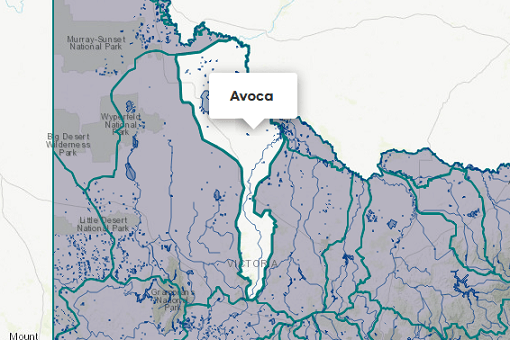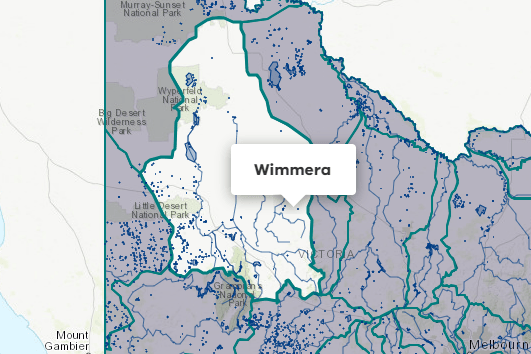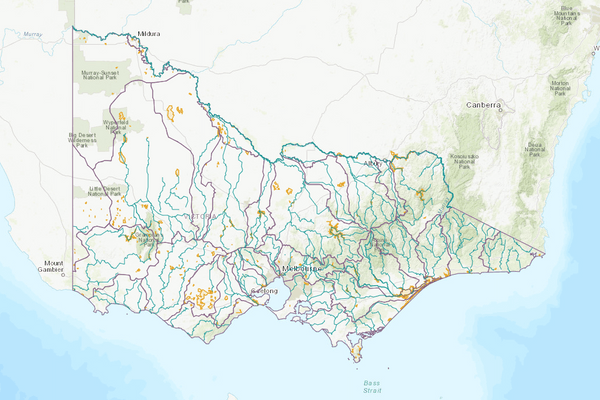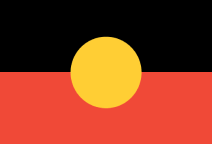About the area
The Mallee basin in Victorias north-west has few well-defined waterways.
The Murray River forms the northern boundary of the basin, and for water accounting purposes, it is included in the water balance of the Murray basin.
The basin's average annual rainfall is around 300-400 mm in the south, decreasing north to below 300 mm at Mildura.
More information on water management and accounting is detailed in Water explained.
2022-23 overview
In 2022-23, the same amount of water was available under entitlements (10 ML) as the previous year.
The Mallee basin relies heavily on groundwater use and almost all surface water used in the Mallee basin is sourced from other basins.
Groundwater use in this area is reported in the West Wimmera and Wimmera-Mallee groundwater catchment reports.
Climate
Rainfall
In 2022-23, rainfall across the entire Mallee basin was very much above the long-term average. This was higher than the previous year when rainfall was above average over most of the entire basin and average along the border with South Australia and the far south of the basin.
Figure 1 displays the rainfall received in 2022-23 compared to the long-term average (1975-2023).
Figure 1: Rainfall deciles, Mallee basin
Sourced from the Australian Bureau of Meteorology
River basin water balance
Almost all surface water used in the Mallee basin is sourced from other basins. The Mallee basin local report does not include:
- a water balance - limited information is available on surface water availability and use
- storages - there are no major storages
- catchment inflow, or an estimation of the volume of water leaving the basin - there are no well-defined streams other than the Murray River which is reported in the Murray basin
- diversions information
- wastewater treatment plants information
- small catchment dam information - while there are some small catchment dams in this basin, no information about them is available, and they are not a significant source of water in the basin.
Entitlements and compliance
Entitlements provide the basis for how water is shared in the basin.
Entitlement volumes
Rights to water in the Mallee basin are shown in Table 1.
Table 1: Annual entitlement volumes at 30 June, Mallee basin
Available water and take under entitlements
Total water available under entitlements represents the volume of water that was available to be taken by entitlement holders in 2022-23.
More information on available water and take has been detailed in How we account for surface
Table 2: Available water and take under entitlements, Mallee basin
Compliance
Compliance against water entitlements is reported for this basin in one area:
- entitlement issued: that the volume of entitlements issued in a basin does not exceed formal caps, and has not increased without appropriate approvals
Due to a lack of reliable information, the total volume diverted in the Mallee basin is not estimated.
Total entitlement volume
There was no net increase in the total entitlement volume from the previous year.
Water for the environment
Environmental watering sites
Environmental watering sites in the Mallee basin that depend on water for the environment include the internationally significant Hattah Lakes system, the Lindsay-Mulcra Wallpolla Living Murray Icon site and the lower Murray wetlands including Catfish Billabong in the Merbein Common Flagship Waterway Site.
These environmental watering sites receive environmental water from the Murray River and the Wimmera Mallee pipeline.
Environmental water reserve
In 2022-23, water for the environment from within the Mallee basin comprised all water in the basin not allocated for consumptive use: this water also provided social, recreational and cultural benefits.
Information on the total volume of environmental water delivered in the Mallee basin is reported in the Murray basin local report and the Wimmera basin local report.
Management responsibilities
Management of water in the Mallee basin is undertaken by various parties
| Authority | Management responsibilities |
|---|---|
| Grampians Wimmera Mallee Water |
|
| Lower Murray Water |
|
| Mallee Catchment Management Authority |
|






